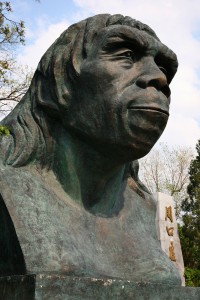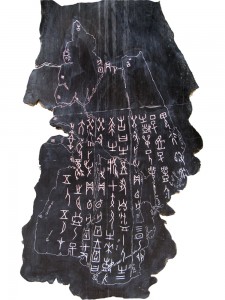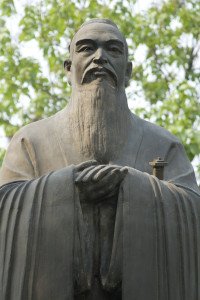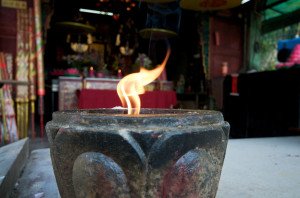Part I – A Formative Age: Prehistory 780,000 BCE – Zhou Dynasty 1046-221 BCE
Introduction – Emerging Great Themes of Dynastic History
The China that we see today had its origins in Prehistory. The remains of one of our earliest human ancestors, Peking Man, were found near the Zhoukoudian cave system located about 50 km southwest of Beijing. As early as 780,000 BCE, cave dwellers lived in China. Beginning in approximately 8000 BCE, people in north and central China began domesticating animals and growing food, especially millet, in the Yellow River valley of the north and rice in the Yangtze River valley to the south. A warming climate aided agricultural innovation. The surplus food production allowed more populous and complex societies to evolve. By 5000 to 4000 BCE Neolithic settlements were scattered throughout China. By 2000 BCE these village settlements saw people begin to specialize in different kinds of productive occupations. Agricultural production supported a growing non-agricultural population including artisans producing non-agricultural goods, administrators who collected taxes and set rules and regulations for society, and soldiers who defended and expanded the territory under the government’s control. Dating approximately from 2200-1600 BCE the Xia Dynasty was China’s first dynasty, although its existence has yet to be corroborated by archaeological evidence. The Shang (1600-1046 BCE) and the (Zhou 1046-221 BCE) saw the great themes of Chinese civilization begin to develop with the mastering of large scale mining and bronze casting, the development of writing, and the creation of a bureaucratic infrastructure to manage the expanding state. Religious and philosophical paradigms began to be formed, around which society could be structured and the world understood.
Over 4000 years of history, China has shown great continuity of values and purpose. There were times when it fractured into many smaller states, yet each of these states maintained many of the core political, social and religious power systems which came to define the Chinese civilization. Many factors contributed to China’s cultural continuity despite its periods of political disunity. One key factor was China’s formidable geography. Mountains, deserts and oceans formed real barriers between China and the rest of the world. For much of China’s history, its main threat came from the nomadic people who lived in the north. China built, and rebuilt the Great Wall, a 4000 mile barrier, along its northern border to stop invasions by these horse-riding “barbarians”. China’s cultural continuity was also facilitated by a common written language that allowed people throughout the empire to communicate, despite their many different dialects that were often mutually unintelligible. The ability to correspond in written form throughout China enabled governmental edicts to be communicated territory-wide, reinforcing the effectiveness of a strong, centralized, governmental bureaucracy. It also allowed the dissemination of philosophical, religious and cultural thought. From early on, China created a considerable body of literature, much of which was concerned with how people lived and behaved. This literature helped build a commonality of values throughout China. The Chinese invention of book printing helped spread these values further, as did its emphasis on education as a way to reach the highest levels of society.
These edicts also ordered the building of unprecedented engineering works – the Great Wall and the Grand Canal to name but two – that also brought the country together. China’s basic religion of ancestor worship also proved to be a strongly unifying. This ancient religion stressed the duty of sons to care for parents before and after death. By 550 BCE, Confucius expanded this pattern of obligation to include loyalty to the Emperor and the state.
780,000-2200 BCE
Even before there was Chinese civilization, there was primitive human life in what came to be China. Early human occupation of the area began over 1.7 million years ago. In the 1920s, near the Chinese village of Zhoukoudian, Peking Man was discovered. This early human lived in the area’s caves from roughly 780,000 to 600,000 BCE. Peking Man hunted and cooked animals, used sharpened stone tools, and had an intelligence level somewhere between that of apes and modern man. By 10,000-8000 BCE, in early north and central China, the Chinese people began farming and domesticating animals. By 3000 BCE, the Chinese had developed painted pottery, made relatively sophisticated tools and created decorative objects of Jade. By 2000-1500 BCE, Chinese settlements produced enough food to support artisans, soldiers and administrators who collected taxes and governed society.
Xia Dynasty: Approximately 2200-1600 BCE
China’s earliest cultural heroes from this time were called the three Sage-Kings – Yao, Shun and Yu – who were known for their morality and commitment to the wellbeing of their subjects. This theme of Chinese rulers who are both virtuous and committed to their people’s welfare runs throughout Chinese history. The Chinese believed humans could constantly improve themselves. From early on, Chinese leaders placed great value on education, and on choosing rulers and governing bureaucrats based on their capabilities, not just based on their connections. Yao, for instance, passed his throne onto Shun, rather than his own son, because Shun was most devoted to the people’s interests. Shun in turn chose an engineer, Yu, who began developing techniques to control river flooding. Yu, however, did pass his rule to his son, creating what is believed to be the first of the Chinese dynasties, the Xia. The Xia is the first dynasty to be described in ancient records including the Records of the Grand Historian and the Bamboo Annals, although scholars still debate whether the dynasty actually existed.
Shang Dynasty 1600 BCE-1046 BCE – Character Writing, Engineering and An Optimistic Outlook
Tradition has it that the moral superiority of King Tang, the first Shang Dynasty ruler, enabled him to overpower the last Xia ruler Jie, known for his atrocities, neglect and incompetence. This lifecycle of the Xia Dynasty – from the estimable founder through a series of often unexceptional rulers to the corrupt and ineffectual tyrant – became a pattern of subsequent dynastic cycles.
Archaeological evidence suggests that the early Shang Dynasty was quick to develop a political hierarchy and a complex economic and social system. Shang cities, for instance, were large and protected by massive walls up to 40 m wide and 10 m high, the largest of which are estimated to have required an investment of some 13 million labor days. The Shang leadership seemed adroit at mobilizing thousands of conscripts for such mass projects which also included military campaigns, the construction of tombs for deceased kings, and the clearing of new lands. Much attention was given to the efficient maintenance of these human resources, especially improving agriculture efficiency. This ability to mobilize large labor pools to achieve state objectives became a hallmark of Chinese dynasties from the Shang onwards.
The Shang territory was ordered in system of towns and villages ruled by the king’s relatives. Land near the Shang capital (Yan, present day Qufu, also the birthplace of Confucius) was entrusted to the king’s immediate clan. More distant areas were ruled by descendants of former Kings, and by allies of the royal lineage. Maintaining these alliances required effective diplomacy. Diplomatic tools included marriage, economic and military strength – some Shang armies numbered over 10,000 soldiers – diplomatic visits, Shang respect for the deities and ancestors of the other lineages, and employment of alien dignitaries in the Shang court. Allied courts paid tribute to the Shang by sending animals and prisoners of war, which were often sacrificed to placate ancestors.
“Oracle bones” – chicken bones and turtle shells – dating from the Shang time, record the first examples of Chinese character writing. These bones were used by rulers to consult ancestral spirits. The Chinese believed that the afterlife reflected the hierarchy of life on earth, and they saw their own dead ancestors organized in a pyramid of power with more distant ancestors being more powerful than those recently deceased. At the top of the Pyramid was the “Lord on High”, whom they believed to be the mightiest spirit of all. Shang rulers believed that many natural and political phenomena, from drought to foreign invasions, were the result of divine powers. Yet the Chinese were not fatalistic; instead, optimistically believing that relations with deities were manageable and that malevolent deities could be controlled by enlisting the help of royal ancestors. To ensure ancestral support, elaborate burial tombs were constructed and, after burial, communication with the dead was made through regular sacrifices. Over time, Shang religious activity became more ritualized. For instance, communication with ancestors occurred on specific days, which was enabled by the invention of calendar keeping.
The Zhou Dynasty 1046 BCE-221 BCE – Legalism, Confucianism, Daoism and the Mandate of Heaven
Around 1045 BCE, the Zhou conquered the Shang. Exactly what caused the Shang to lose their hegemony is not clear. The diminished dependency of Oracle bone divination’s over time means that their inscriptions became less informative. What seems clear is that the Shang state decreased in size in the 11th century BCE. Allies and dependencies of the Shang whose names frequently occur in earlier inscriptions disappear from those of the last 50 years of Shang rule. Additionally, the last ruler of the Shang appeared to be a cruel tyrant who putatively engaged in such acts as dismembering one of his aides and pickling another, enjoying orgies, and generally neglecting state affairs.
The Zhou worshipped Heaven, a benevolent force that helps right triumph in human matters. The Zhou conquerors argued that the last Shang kings were corrupt and irresponsible and that Heaven therefore granted the Zhou the right to rule in their place. Thus was created the “Mandate of Heaven”, the idea that Heaven bestows on an honorable and noble leader the right to rule, an idea that was to remain prevalent throughout Chinese dynastic rule.
The Zhou consolidated rule by weakening what was left of Shang dynastic power. Shang elites were relocated close to the center of power and Zhou settlements were established in strategic places throughout its territory. The Zhou slowly discarded the Shang custom of large-scale human sacrifices. Oracle bone divination gave way to prophecy based on an ancient text called the Book of Changes, which argued that ethical behavior brought favorable outcomes while immoral behavior jeopardized dynastic rule. In 770 BCE, the Zhou lost control over regional polities and the capital was conquered by two former Zhou vassals. The surviving court retreated to establish a new capital several hundred miles to the east. Thus 1045-770 BCE is called the Western Zhou period, while 770 BCE-256 BCE is the Eastern Zhou.
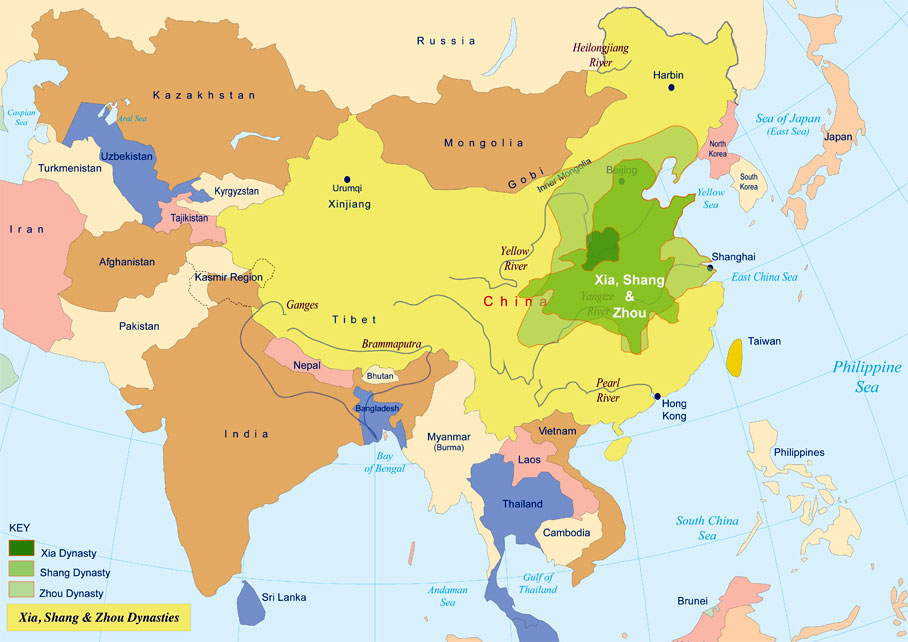
Spring and Autumn Period and the Warring States Period
In the 8th century BCE, Zhou power became fragmented in the Spring and Autumn period (770 BCE-453 BCE), named after the influential Spring and Autumn annals, and the Warring States period (453 BCE – 221 BCE). In the Spring and Autumn period hundreds of states eventually arose, each submissive to Zhou kings in name only. Yet despite this political fragmentation, much cultural uniformity was preserved as nobles maintained the practice of Zhou ritual culture. Eventually, during the Warring States period, these smaller polities were gradually consolidated into seven larger powers, including the Qin in the West. These seven larger powers expanded aggressively, ultimately conquering territory that, if conglomerated, began to anticipate the eventual borders of the Chinese nation. These states centralized control over their territory, discouraging autonomous political units which were viewed to be the cause of the constant warfare. Large numbers of commoners were rallied to build walls, dams, dikes and irrigation canals, meaningfully raising the yields of millet, wheat, soybean and rice crops which allowed these states to support large standing armies. Rulers increasingly recruited commanders based on skill and organizational abilities rather than on birth. This began China’s emphasis on creating an intellectual elite to help rulers maintain their hegemony, and introduced the idea of social mobility based on meritocracy.
During the Spring and Autumn period, in what became known as the “Period of a Hundred Schools of Thought” (famously recalled by Mao Zedong during his “Hundred Flowers” campaign), China considered many aspects of how society should be governed and how people should behave as it searched for an end to constant combat. An important school of thought during this time was the Legalists who argued that hegemony was achieved through the creation of severe laws with harsh punishments under the theory that harsh punishment deterred undesirable behavior. They supported the promotion of soldiers and officials on the basis of ability not just relationships and blood, and believed that rulers should pursue the goal of a powerful universal state. The Art of War, attributed to Sunzi (frequently written as Sun Tzu), was written during this time and is still studied today both in China and across the world.
Confucius
Competing with this view were the ideas developed by Confucius. Born in 551 BCE, Confucius argued that the welfare of the people was more important than the privileges of the ruling class. Confucius also believed that officials should be chosen on the basis of ability not birth. Although he was agnostic about spirits, Confucius nevertheless believed that it was important to express respect and gratitude for dead forefathers. He thought the wisdom of the ancients should be studied so their insight could be passed on to future generations. He believed in the idealistic vision of benevolent rule, and thought that all people have the capacity for kindness. Yet he thought that this goodness needed to be nurtured through education, ritual, and the imitation of righteous role models. These role models included the example of parents, teachers and the great moral leaders of the past. He believed in social hierarchy and that sons were to be obedient to fathers as fathers should be obedient to their rulers. He also believed that scholars should study poetry, music and history to broaden their minds, a tradition that was to become entrenched within the Chinese dynastic civil service. While Confucius is, arguably, the most influential Chinese philosopher that has ever lived, it was not until after his death that his ideas gained wide acceptance and became entrenched in Chinese culture. Later followers of Confucius such as Mengzi (often referred to in the West as Mencius) and Xunzi thought those that worked with thought should rule over those who toiled with their hands, yet these rulers were obliged to be moral and just. Rulers received the Mandate of Heaven when they cared for their people; those who exploited their subjects lost the Mandate and failed. Xunzi also argued that events like droughts, floods or hurricanes were part of the natural world, not divine retribution for poor rule. A ruler lost the Mandate of Heaven not because a hurricane occurred, but because the ruler failed to respond to it compassionately and effectively.
Daoism also developed during this time and spoke in more philosophical terms about the nature of life and state. Dao means “the way”, and is a metaphysical construct that considers the totality of the universe and its laws of nature, trying to understand within that whatever is unchanging and everlasting. It seeks harmony with this natural, unchanging force in order to create a harmonious and stable society.
The Past in the Present – Historical Themes in Today’s China
Confucianism, with its teachings of respect and loyalty for one’s parents, husbands and rulers created a tight knit society where one’s own individual desires were often subjugated to those in more favorable hierarchical positions. China’s worship of its ancestors extended this respect for, and deference to, its elders into the afterlife. The emphasis on education as a means of political advancement meant that the leaders of China shared a common culture as they all studied the same body of literature in order to pass their examinations. The spread of these cultural values to all parts of China was facilitated in part by China’s early creation of character writing. It also allowed the edicts of the government to be communicated throughout China, even though China had (and still has) many diverse spoken dialects.
From early on, the Chinese government was able to mobilize large numbers of its populace to execute works for the public good including the building of irrigation and dyke systems and the construction of city walls. They also conscripted large armies to defend Imperial territory. The Chinese have generally been an optimistic people who believed that their efforts had a direct impact on the outcome of events. For example, instead of attributing a devastating river flood to the wrath of a mercurial God, they instead recognized its natural causes and then set about engineering solutions, often on a grand scale.
Yet, while the political, social and cultural systems characteristic of Chinese civilization became firmly established, who should govern this civilization was periodically put into question. Specifically, there was often tension between the rule of the dynastic court and regional power centers. These regional power centers generally did not want to change the nature of Chinese society; instead, they wanted to take the rule of this society for themselves.
Many of these themes are still prevalent in China today. China is still ruled by a centralized, bureaucratic, authoritarian government. Education is still given the highest importance; success in university entrance exams allows those from even the humblest backgrounds to have the promise of future upward mobility, though, as with other modern societies, those already with power and wealth have a structural advantage. Before China’s market opening in 1978, communist ideology absolutely subjugated individual aspiration to the good of society as a whole. While the creation of the largely-capitalist economic system has now allowed for more individual aspiration (at least in economic terms), it has also undermined the Chinese Communist Party’s (CCP) justification for rule. The CCP has countered this in part by promoting nationalism, which among other things, celebrates the prestige of its 4000-year-old history, including its Confucian tradition, something that had previously been played down during the Mao years. This Confucian revival can be seen, for instance, in China’s building of Confucian centers around the world to promote the teaching of Chinese language and culture.
China still has an amazing capacity to mobilize its populace for the benefit of the public good, as evidenced by the current, unprecedentedly rapid building of infrastructure including roads, railways, hydro-electrical and other power systems. The Chinese are still optimistic in their ability to solve nature’s challenges and, thus, optimistic about their ability to control their future destiny. For instance, their hugely ambitious South-North Water Diversion Project will divert at least six trillion gallons of water each year from the Yangtze River to satisfy the water needs of the North China Plain and its 440 million people, thus tackling a growing water crisis in northern China.
Tensions between Beijing and provincial powers remain today, reflecting the struggles of bygone eras between the center and the regions. As China has transitioned from a communist to a largely-capitalist economic system, some regional areas and municipalities have grown in power and importance, posing a challenge for the regime in maintaining its absolute control.
What Happened Next?
The development of cultural norms, based around Confucian ideals, and the establishment of centralized governmental systems in order to pacify the restive regions continued after the Zhou, with the successes of first the Qin and then the Han. Similarly, the tendency for grand projects also manifested itself with the first creation of a ‘Great Wall’ on China’s northern frontier and the development of the Grand Canal. The story continues in A Classic, Bureaucratic Empire.


